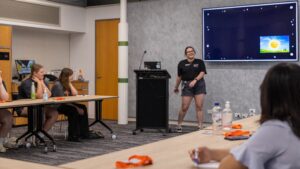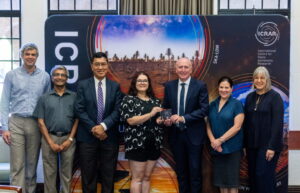“Turn your face towards the sun, and the shadows fall behind you.” – Charlotte Whitton, feminist and social policy pioneer
I am a current PhD candidate studying across ICRAR and CSIRO Space & Astronomy, based at Curtin University.
Just as stars twinkle in the night sky, distant galaxies will twinkle because of the erupting storms from the Sun, and this is the topic of my PhD. The last 3 years of my life has been dominated by monitoring the space weather environment using interplanetary scintillation (IPS) using the Murchison Widefield Array (MWA), working under the supervision of Dr Ramesh Bhat at ICRAR, Dr John Morgan and Dr Mark Chueng at CSIRO, and Prof Melanie Johnston-Hollitt at the Curtin Institute of Data Science.

Alongside my academic career, I am an advocate for women and young people in STEM, working as a STEM Communicator at Curtin STEM Outreach for over 5 years, and recently working alongside the ICRAR Outreach and Communications team. I spend my time bringing science into schools and getting students into science! Working on programs such as DISCOVER, Astrofest, IAES, and the many, many school visits, I have championed women in STEM and promoted STEM engagement in hundreds of schools and thousands of students across the WA coastline.
Academic Career
I have been working and researching topics related to space weather for the entirety of my academic career, starting close to the Earth, studying the ionosphere in my 3rd year and my Honours thesis, and moving out into the cosmos, closer to the Sun, in my PhD.
I started my time at ICRAR as a bright-eyed 3rd year student, studying my Bachelor of Science at Curtin University. Stumbling upon the Epoch of Reionisation team, I started work under Dr Chris Jordan and Dr John Morgan investigating interesting moving structures in the ionosphere, one of the upper layers of Earth’s atmosphere. Linking the appearance of these mysterious structures to magnetic eruptions on the Sun was my first taste of space weather, and I knew from that moment, I was hooked!
This is also the time that I was first introduced to the MWA, the very first radio telescope that I used (and I still use to this day). I learnt how radio data was collected, processed, and even imaged, and I had my first tries at using a supercomputer.
I continued to work with Chris and John for my Honours’ project, studying a different aspect of the Earth’s ionosphere, the way that it can effect incoming radio waves through the phenomenon of scintillation. Titled Measuring Ionospheric Scintillation at Low Frequencies, my work broadened to studying the ionospheric environment above the MWA. This work resulted in my first academic publication, A measurement of small-scale features using ionospheric scintillation; Comparison with refractive shift measurements.
After the conclusion of my Honours, I was excited to remain at ICRAR and to continue working in the field of space weather.
So far, I have published one academic paper as part of my thesis, titled Resolving Moving Heliospheric Structures Using Interplanetary Scintillation Observations With the Murchison Widefield Array, with several more in the pipeline.
 In the 2nd year of my PhD, I had the honour to receive the 2023 Ken and Julie Michael Prize from ICRAR in recognition of my outstanding achievements as a graduate student. This annual prize is awarded to students within the institute with the most impactful piece of research in the field of astronomical science, and who have best demonstrated their own personal excellence in their research. As part of this award, I was given the opportunity to present my work to the ICRAR board and the WA Minister for Science, the Hon Stephen Dawson.
In the 2nd year of my PhD, I had the honour to receive the 2023 Ken and Julie Michael Prize from ICRAR in recognition of my outstanding achievements as a graduate student. This annual prize is awarded to students within the institute with the most impactful piece of research in the field of astronomical science, and who have best demonstrated their own personal excellence in their research. As part of this award, I was given the opportunity to present my work to the ICRAR board and the WA Minister for Science, the Hon Stephen Dawson.
A bit more about the science
Just as stars twinkle in the night sky because of atmospheric interference, compact radio sources light years away will twinkle due to turbulence in the solar wind, a phenomenon known as interplanetary scintillation (IPS). This very effect can be useful in both studying said radio sources and for making measurements of the solar wind. This also makes IPS very sensitive to intense changes in solar wind which could be caused by large space weather events, such as a coronal mass ejection where a physical chunk of the Sun is ejected into the solar system, a plasma with an embedded magnetic field, carrying with it highly charged particles.
Major space weather events, such as large solar flares and powerful CMEs, if aimed at Earth are a huge potential risk to our technology and our modern-day ways of living. One such devastating event has already occurred in 1859, where a major CME directed at Earth created the most intense geomagnetic storm in recorded history, named the Carrington event, after British astronomer Richard Carrington. This solar storm created strong global auroral displays spotted as close to the equator as Colombia, and caused sparks and fires at multiple telegraph stations, with some telegraph operators reporting they were shocked while touching their equipment. Similar less severe events have occurred again in 1921 and 1960, where widespread radio disruptions were reported. If another Carrington-like event were to hit Earth today, with our worldwide electrical systems it is estimated to cost US$0.6-2.6 trillion in damages to the US alone, and if major enough, the collapse of society itself. It is therefore not hard to understand that one of main objectives in studying solar activity is to predict not only the severity of these events, but the occurrence of them.
Although the Sun is closely monitored by other missions and projects such as NASA’s STEREO and ESA/NASA’s SOHO with LASCO, with the SWPC on constant look out for a CME’s Earth-impact likelihood, a large number of solar events are being missed, and those that are captured are all studied within close proximity of the Sun, which leads to gaps in humanity’s understanding of how these solar storms occur and behave. The expectation of my project is that not all MWA events will have been detected previously and that these measurements will be able to significantly refine our understanding of how the ejections evolve as they move further away from the Sun. Using both the MWA’s IPS data, alongside our other ancillary data such as dual-frequency solar imaging, the main goal is to reconstruct the inner heliosphere as accurately as possible, with an additional objective of extracting polarimetry to study the magnetic fields in remote parts of the heliosphere.
ICRAR Statement
The content of this page is maintained by Angie Waszewski, please contact them with any questions or comments on this content.